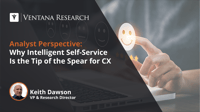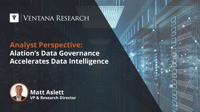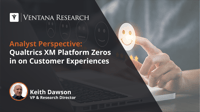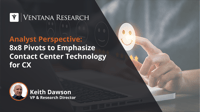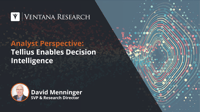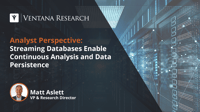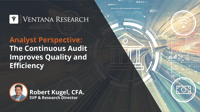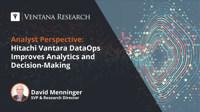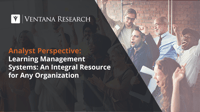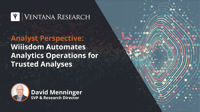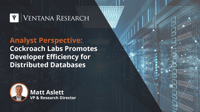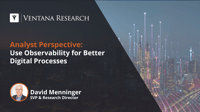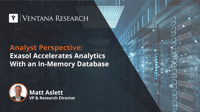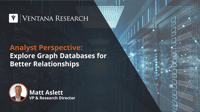We are happy to share insights gleaned from our latest Value Index research, an assessment of how well vendors’ offerings meet buyers’ requirements. The Ventana Research Value Index: Total Compensation Management 2023 is the distillation of a year of market and product research by Ventana Research. Drawing on our Benchmark Research, we apply a structured methodology built on evaluation categories that reflect the real-world criteria incorporated in a request for proposal to human capital...
Read More
Topics:
Human Capital Management,
Total Compensation Management
Having just completed the 2023 Ventana Research Value Index for Total Compensation Management, We want to share some of my observations about how the market has advanced since our assessment three years ago. For more than two decades, Ventana Research has conducted market research in a spectrum of related areas including Total Compensation Management (TCM) as well as broader HCM areas ranging from employee experience, learning management, workforce management (WFM) to payroll management and...
Read More
Topics:
Human Capital Management,
Total Compensation Management
Early last December, just before ChatGPT became the new, bright, shiny object, The Economist magazine ran a story proclaiming that we had finally arrived at the age of boring artificial intelligence (AI). From my perspective, it’s unfortunate that didn’t last and that AI has been relegated back to the buzzword league. AI will be an increasingly important feature of business software through the end of this decade. Ventana Research asserts that by 2026, almost all vendors of software designed...
Read More
Topics:
Office of Finance,
Business Intelligence,
Business Planning,
Enterprise Resource Planning,
ERP and Continuous Accounting,
natural language processing,
continuous supply chain,
digital finance,
AI & Machine Learning,
Purchasing/Sourcing/Payments,
Consolidate/Close/Report
Organizations looking to improve the customer experience and contact center operations should closely examine the processes at work in the front-end self-service environment. Technology advancements are converging at this gateway, including artificial intelligence, chatbots and knowledge management. The front end of the customer interaction offers a greater opportunity for customer engagement than most organizations realize.
Read More
Topics:
Customer Experience,
Self-service,
Contact Center,
Knowledge Management,
Chatbots,
agent management,
Intelligent Self-Service
As data continues to grow and evolve, organizations seek better tools and technologies to employ data faster and more efficiently. Finding and managing data remains a perennial challenge for most organizations, and is exacerbated by increasing volumes of data and an expanding array of data formats. At the same time, organizations must comply with a growing list of national and regional rules and regulations, such as General Data Protection Regulation and the California Consumer Privacy Act....
Read More
Topics:
Data Governance,
Data Management,
Data,
data operations
As a rule, I dislike terms like “digital finance transformation” because there’s a wave-the -magic-wand quality to it that obscures the not-so-simple people and process elements necessary for true transformation. Six of the most common – and expensive – words used in an accounting department are “we’ve always done it this way.” Persuading staff to change can be a struggle, even if change makes their jobs easier and more rewarding. Moreover, digital transformation must cover the data elements as...
Read More
Topics:
Office of Finance,
digital finance,
Consolidate/Close/Report
Modern business relies on having a clear, continuous understanding of customer perceptions and intentions. That insight is increasingly used to deliver them experiences that they would consider excellent, in turn leading to higher satisfaction and more profitable relationships. Qualtrics, a provider of Experience Management (XM) software, focuses on creating applications that analyze customer interactions and feedback so that different teams across the enterprise can better identify...
Read More
Topics:
Customer Experience,
Voice of the Customer,
Contact Center,
agent management,
Customer Experience Management
At its March 2023 analyst conference, 8x8 described a significant pivot in its focus. Going forward the company will be emphasizing the Contact Center (CCaaS) side of its portfolio, which to this point has represented a small portion of its overall sales. It made several product announcements to bolster the argument that it can effectively meet the needs of complex contact center operations while continuing to provide business users with a UCaaS solution. The overall XCaaS platform is aimed at...
Read More
Topics:
Customer Experience,
Contact Center,
Customer Experience Management
Organizations are continuously searching for new business opportunities hidden in their data. They are using various technologies including artificial intelligence and machine learning (AI/ML) to uncover granular insights that can support decision-making. Existing tools and dashboards are effective for observing standard metrics; however, they do not address follow-up questions, such as why things are happening or how those events impact performance. Organizations also struggle to derive...
Read More
Topics:
Analytics,
Business Intelligence,
natural language processing,
AI & Machine Learning,
Decision Intelligence
Success with streaming data and events requires a more holistic approach to managing and governing data in motion and data at rest. The use of streaming data and event processing has been part of the data landscape for many decades. For much of that time, data streaming was a niche activity, however, with standalone data streaming and event-processing projects run in parallel with existing batch-processing initiatives, utilizing operational and analytic data platforms. I noted that there has...
Read More
Topics:
Analytics,
Data,
Digital Technology,
Streaming Analytics,
Analytics & Data,
Streaming Data & Events,
operational data platforms,
Analytic Data Platforms
An external audit examines an organization’s performance of accounting tasks. It validates the soundness of accounting systems and policies and compliance with generally accepted accounting principles in preparing financial statements – chiefly the income statement, balance sheet and statements of cash flow and equity. The auditor certifies that there are no material errors or omissions, and that the financial statements are compliant with requirements. Technology can transform this process to...
Read More
Topics:
Office of Finance,
digital finance,
Consolidate/Close/Report
I have previously written about the importance of data democratization as a key element of a data-driven agenda. Removing barriers that prevent or delay users from gaining access to data enables it to be treated as a product that is generated and consumed, either internally by employees or externally by partners and customers. This is particularly important for organizations adopting the data mesh approach to data ownership, access and governance. Data mesh is an organizational and cultural...
Read More
Topics:
Cloud Computing,
Data Governance,
Data Management,
Data,
Digital Technology,
data operations,
Analytics & Data
Now more than ever, effective data management is crucial to enable decision-makers to better assess information and take calculated actions. It is also important to keep up with the latest trends and technologies to derive higher value from data and analytics and maintain a competitive edge in the market. However, every organization faces challenges with data management and analytics. And as organizations scale, the complexity only increases, creating a need for better data governance, data...
Read More
Topics:
Analytics,
Data Governance,
Data Management,
Data,
data operations,
Analytic Data Platforms
I am happy to share insights gleaned from our latest Value Index research, an assessment of how well vendors’ offerings meet buyers’ requirements. The Learning Management Value Index 2023 is the distillation of a year of market and product research by Ventana Research. Drawing on our Benchmark Research, we apply a structured methodology built on evaluation categories that reflect the real-world criteria incorporated in a request for proposal to learning management vendors supporting the...
Read More
Topics:
Human Capital Management,
Learning Management
Having recently completed the 2023 Ventana Research Value Index for Learning Management Systems (LMS), I’d like to share some of my observations about how the market has advanced since our assessment three years ago.
Read More
Topics:
Human Capital Management,
Learning Management
A decade ago, organizations were sold on best-of-breed technology stacks. In the world of human capital management, that meant a separate system for each of the myriad processes that make up a worker's life span with a company. The approach seemed to make sense because a single system cannot be the best at everything, can it? Is it realistic for a single provider to create the most advanced applicant tracking, onboarding, learning, payroll, compensation, performance management, succession...
Read More
Topics:
Human Capital Management,
Talent Management,
employee experience
Data analytics provide valuable insights and enable organizations to make better decisions, improve performance and gain a competitive advantage in the marketplace. Analytics can change frequently depending on the data being analyzed and the methods used to gather and process it. Factors such as new data, changes in the underlying systems or updates to algorithms can all contribute to differences in an analysis. AnalyticOps helps ensure data is accurate, up-to-date and consistent across...
Read More
Topics:
embedded analytics,
Analytics,
Business Intelligence
I recently wrote about the potential use cases for distributed SQL databases as well as techniques being employed by vendors to accelerate adoption. Distributed SQL is a term that is used by several vendors to describe operational data platform products that combine the benefits of the relational database model and native support for distributed cloud architecture, including resilience that spans multiple data centers and/or cloud regions. I noted that compatibility with existing database tools...
Read More
Topics:
Cloud Computing,
Data,
Digital Technology,
Analytics & Data,
operational data platforms
I am happy to share insights gleaned from our latest Value Index research, an assessment of how well vendors’ offerings meet buyers’ requirements. The Ventana Research Value Index: Product Experience Management 2023 is the distillation of a year of market and product research by Ventana Research. Drawing on our Benchmark Research, we apply a structured methodology built on evaluation categories that reflect the real-world criteria incorporated in a request for proposal to vendors supporting the...
Read More
Topics:
Marketing,
Product Information Management,
Operations & Supply Chain
For 2023, the Office of Finance practice of Ventana Research introduced Close, Consolidate and Report as one of its six focus areas. The change reflects the recent evolution of technology that supports this part of the finance department calendar. Ventana Research expects that the increasing investment in software to streamline these processes will, by 2026, result in two-thirds of finance and accounting departments improving their use of readily available technology to close quarterly books...
Read More
Topics:
Office of Finance,
digital finance,
Consolidate/Close/Report
We added purchasing, sourcing and payments to our core Office of Finance focus areas this year to reflect new and important opportunities to use technology to gain effectiveness through greater efficiency. Doing a better job of record-keeping and organizing paperwork – especially in a minutiae-laden process like source-to-pay – may seem trivial. Yet digitally transforming core business processes became essential as the pandemic required organizations to lock down in early 2020, and the need to...
Read More
Topics:
Office of Finance,
ERP and Continuous Accounting,
Purchasing/Sourcing/Payments
Having just completed the 2023 Ventana Research Value Index for Product Experience Management, I want to share some of my observations about how the market has advanced over the last two years. The product information management software market is quite mature and products from any of the vendors we assess could be used to effectively deliver information to help your organization improve its operations. But as we established the definition of product experience management (PXM), the...
Read More
Topics:
Marketing,
Product Information Management,
Operations & Supply Chain
Having just completed the 2023 Ventana Research Value Index for Product Experience Management, I want to share some of my observations about how the market has advanced over the last two years. The product information management software (PIM) market is quite mature and products from any of the vendors we assessed can be used to effectively deliver information to help your organization improve its operations. But as we established the definition of product experience management (PXM), the...
Read More
Topics:
Marketing,
Product Information Management,
Operations & Supply Chain
For years various types of systems have produced log files to help with monitoring, debugging and performance management. Often, this information was used in forensic analyses of why interruptions in service or other problems occurred. In many cases, log files are still used this way. But systems have grown more complicated, and many more devices are instrumented. Systems have been decomposed into much finer-grained, interdependent services. Infrastructure is now distributed between on-premises...
Read More
Topics:
Business Continuity,
Digital Technology
Digitally transforming core business processes became essential as organizations locked down in early 2020 because of the pandemic and the need to operate remotely presented a set of new challenges that were best addressed by software. Especially in the areas of sourcing, purchasing and payments, software has the ability to streamline processes, shorten process cycles, reduce unnecessary costs, provide greater visibility into cash flows, increase control and improve results. Digitizing...
Read More
Topics:
ERP,
Office of Finance,
continuous supply chain,
digital finance,
Purchasing/Sourcing/Payments
Organizations require faster analytics to continuously improve business operations and stay competitive in today’s market. However, many struggle with slow analytics due to a variety of factors such as slow databases, insufficient data storage capacity, poor data quality, lack of proper data cleansing and inadequate IT infrastructure. Challenges such as data silos can also decrease operational efficiency. And as the data grows, performing complex data modelling becomes challenging for users as...
Read More
Topics:
Data Management,
Data,
Analytic Data Platforms
Contact centers are very often keen on optimizing their costs through automation. Technology vendors supplying this market have recognized this need, and in the past few years, they have been putting workflow and automation tools front and center in their offerings. This has raised some questions among practitioners about the most effective strategies for implementing automated processes.
Read More
Topics:
Customer Experience,
Contact Center,
agent management,
Intelligent Self-Service
I have been involved with customer relationship management for over 15 years, and although that is not as long as the category has been around, it does coincide with an era where companies and commentators are calling into question the application’s effectiveness. To counter this perception, both CRM vendors and complementary third-party “add-ons” have developed new functionality that aims to improve the “R” in CRM, especially as it relates to sales engagement. But much of this additional...
Read More
Topics:
Revenue Management,
Sales Engagement,
Office of Revenue
Maersk is closing its TradeLens joint venture with IBM that began in 2018. It was intended to enable port operators, customs authorities, freight forwarders and importers to track containers and their contents. The system was designed to substantially reduce the inefficiencies and delays created by paper-based systems used for customs, trade finance, tariffs and taxes as well as supply chain and logistics management. The initiative was designed to cut supply chain latency by reducing the time...
Read More
Topics:
Operations & Supply Chain,
blockchain,
continuous supply chain,
operational data platforms
Recruiting is hard. The best candidate often isn’t even actively looking for a new role, and yet recruiters are expected to find the perfect match of skills, experience and fit at exactly the right time and somehow convince that individual to leave a familiar role and work community to join a new organization. Those who are already in the market have gone to considerable lengths to ensure their credentials stand out from the competition, from creating new resumes to forging new professional...
Read More
Topics:
Human Capital Management,
Talent Management
I have previously written about the functional evolution and emerging use cases for NoSQL databases, a category of non-relational databases that first emerged 15 or so years ago and are now well established as potential alternatives to relational databases. NoSQL is a term that is used to describe a variety of databases that fall into four primary functional categories: key-value stores, wide column stores, document-oriented databases and graph databases. Each is worthy of further exploration,...
Read More
Topics:
Data,
operational data platforms




